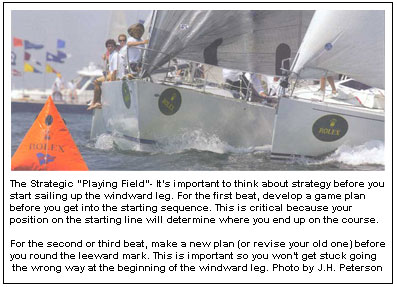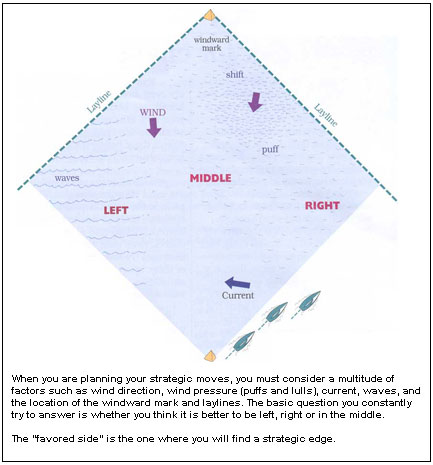| Make
a ‘Game Plan’ For The Windward Leg
by David Dellenbaugh
 It’s
critical to have a good strategic plan for the
windward leg because that is usually where the
fleet gets farthest apart. When boats are on opposite
sides of the beat, their separation can be huge,
and even a small change in wind direction, pressure,
or current can have a huge impact on the fleet
standings. It’s
critical to have a good strategic plan for the
windward leg because that is usually where the
fleet gets farthest apart. When boats are on opposite
sides of the beat, their separation can be huge,
and even a small change in wind direction, pressure,
or current can have a huge impact on the fleet
standings.
Of course, if the conditions
never change you don’t have to worry about
strategy. In that case the race will be decided
entirely on speed and tactics. But in reality
the wind is always changing in both velocity and
direction. In fact, the wind is a lot like a snow
flake -it never follows exactly the same pattern
in any two races.
Every race has a unique set
of strategic conditions, and that’s why
you need to develop a new strategy for each race.
This gameplan must be customized to the particular
conditions that you experience in that place at
that particular time.
Strategic ingredients
 There
are many strategic variables that affect how quickly
you get to the finish. The five factors that we
will cover in this issue are wind direction, wind
velocity, course geometry, current, and waves. There
are many strategic variables that affect how quickly
you get to the finish. The five factors that we
will cover in this issue are wind direction, wind
velocity, course geometry, current, and waves.
For each variable, there are two important considerations.
First, is that element uniform across your windward
leg, or does it vary from side to side? For example,
if the wind strength is exactly equal all across
your course, that variable will not influence
your strategy. But if there’s a lot more
wind on one side, that might be the determining
factor in your gameplan.
The second consideration is
how you expect each variable to change as you
sail up the beat. For example, will the wind shift
direction? If the wind direction remains steady,
this will not affect your strategic planning.
But unfortunately this is hardly ever the case.
Almost all five strategic variables change continuously,
and this is something that the top sailors are
always expecting.
Gather information
In order to make a strategic plan for
the beat, you need to gather as much information
as possible about the five strategic areas. This
data should come from knowledge of the past, observation
of the present, and forecasts of the future.
Knowledge of the past
Before the regatta even starts, try to
find out what the wind normally does in the area
where you are sailing. Identifying common trends
can be very helpful in planning a strategy. If
you have raced in that venue many times before,
hopefully you have a notebook filled with strategic
notes. If you haven’t sailed there, talk
to people who are “regulars” and see
what kind of ‘local knowledge’ you
can uncover.
Other good sources of past wind
trends are historical data from local airports
and online data from meteorological buoys.
Observation of the present
This will give you the most valid and
valuable information, so it should be your primary
source for strategic planning. Historical data
and future forecasts are helpful, but there is
no substitute for what you can see and feel in
the course area just before and during your race.
So get out to the race area as early as possible
and observe the wind, current, and waves. Keep
track of wind direction and velocity and look
for trends. Don’t stop doing this when your
warning signal is made - the wind never stops
changing so you have to keep watching it throughout
the race.
Forecasts of the future
In the old days you had to get weather forecasts
from the newspaper, radio, or television and these
were so general (and ‘old’!) that
they were almost completely worthless. Now we
have two much better options: 1) web-based forecasts,
some of which are fairly good; and 2) private
weather and wind forecast services, available
to purchase for your particular regatta.
These private weather forecasts are by far the
best you can get; they usually give you the predicted
wind direction and velocity for each hour of the
day, and in many conditions they are quite accurate.
However, I recommend using them only as a general
guide for strategic planning because your own
observations of the race course will definitely
give you the best and most up-to-date information
available.
Develop your gameplan
A few minutes before the start, or before
you round the leeward mark, review your historical
notes, your current observations and any forecasts
you may have. Then make a strategic plan for the
next windward leg. The basic goal of this process
should be to identify the ‘favored’
side of the beat so you can choose a route that
will get you to the windward mark fastest.
A sample strategy might sound something like this:
“the breeze is oscillating, but also shifting
slowly to the right, and velocity looks steady
across the course. The waves are uniform across
the course and there is no significant current.
Therefore we’ll favor the right side, playing
the shifts and being careful not to overstand.”
Sometimes the wind conditions are very predictable
and it’s easy to come up with a clear strategy;
other times the conditions are extremely unpredictable
and it seems impossible to figure out what will
happen. That’s OK - sometimes the wind is
really a bit random.
Even the top competitors begin sailing many beats
not knowing which side of the course is favored.
When this happens, you simply have to keep strategizing
(i.e. collecting information) as you sail up the
beat. The good thing about doing this while racing
is that you have all the other boats to help you
see the wind patterns.
Sooner or later, you will figure out which side
of the course is better and you can head there.
The key, however, is what you do before you figure
this out. When you’re not sure which side
of the beat is favored, it’s probably best
to stay somewhere near the middle of the course
until things develop.
When I’m hanging out in the middle waiting
for a favored side to appear, I watch my competitors
to see which of them are most threatening. If
the boats on the right seem to be gaining on me,
that side is probably better (and vice versa),
so I head that way.
The key thing about strategizing is that it’s
a fluid, ongoing process. Since the wind and other
variables are always changing, and can’t
stop thinking about them until after you finish.
And when you make a plan for the beat, you must
always be willing to revise it (or throw it away)
if (when) the conditions change.
Dave publishes the newsletter
Speed & Smarts. For a subscription call: 800-356-2200
or go to:
www.speedandsmarts.com
TOP
|

 It’s
critical to have a good strategic plan for the
windward leg because that is usually where the
fleet gets farthest apart. When boats are on opposite
sides of the beat, their separation can be huge,
and even a small change in wind direction, pressure,
or current can have a huge impact on the fleet
standings.
It’s
critical to have a good strategic plan for the
windward leg because that is usually where the
fleet gets farthest apart. When boats are on opposite
sides of the beat, their separation can be huge,
and even a small change in wind direction, pressure,
or current can have a huge impact on the fleet
standings. There
are many strategic variables that affect how quickly
you get to the finish. The five factors that we
will cover in this issue are wind direction, wind
velocity, course geometry, current, and waves.
There
are many strategic variables that affect how quickly
you get to the finish. The five factors that we
will cover in this issue are wind direction, wind
velocity, course geometry, current, and waves.